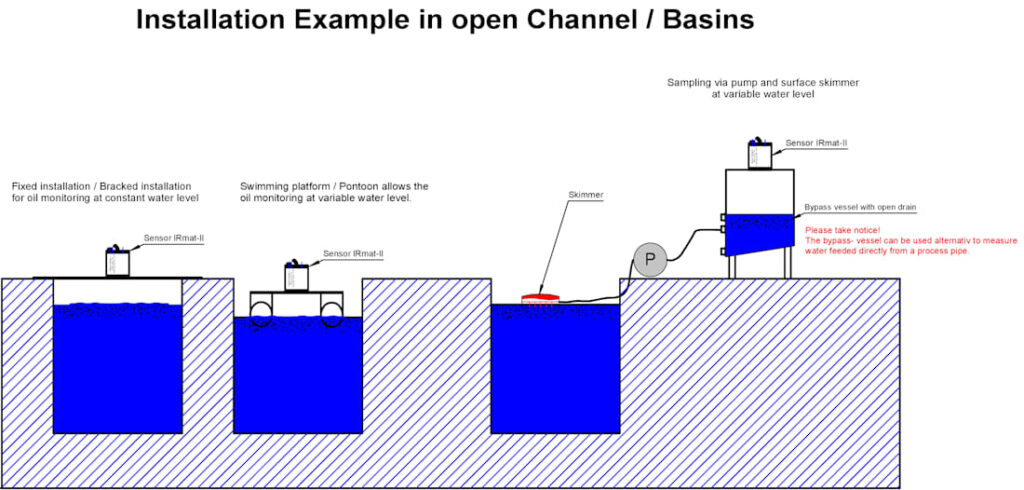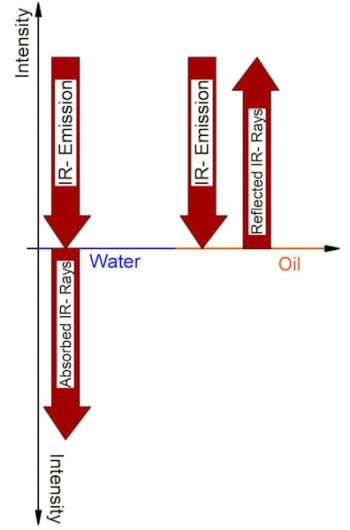Oil monitoring by infrared surface scanning

Task definition
According to the national and international environmental laws concerning water
“every person is liable for taking the necessary precautions, according to the specific conditions, to prevent oil pollution of water”
It is very important that water of industrial plants never introduces oil into the process or into the environment. For this reason, a continuous monitoring of water is necessary at the outlet of those plants, where oil emissions are possible in case of operational malfunctions. The problem is, that produced water carries typically a considerable load of contaminations, e.g. sand, mud, algae or salts. Operation conditions such as temperature, speed of flow or water level are not constant. These changing process properties make it very difficult to get reliable oil monitoring results.
Measurig of the absolute oil amount in mg/l or ppm is not really possible by using the known inline & online measuring systems. Reasoning for this statement is, that oil is not homogeneous distributed in the water. The systems capture only a fraction of the total water quantity for analysis. The biggest quantity of the water is not measured, at installations in open channel, basin, tank or large pipes. Taking a representative sample with average oil content is virtually impossible, because the distribution of the oil fluctuates unpredictably within the water.
Parameter like water depth, temperature, speed of flow and oil type affect the oil distribution in water.
As an example:
Very often you will find no oil in a water depth of 30cm, but there is an oil film on the water surface. Almost all types of oil or at least their components are lighter than water and therefore they float. Due to this property we can expect to get the highest oil concentration at the surface or in the upper region of large pipelines. The oil monitor model IRmat (IR-21) uses the floating characteristic of oil to ensure maximum sensitivity.
Overview of different measurement methods
Various methods are used to detect oil in water:
- UV- stimulated fluorescence
- IR- reflection
- Absorption photometry
- Conductivity measurements at the water surface
- Capacitive measurements
- Transfer of oil in a solvent for hydrocarbons & spectroscopic analysis of the solvent
- Light scattering turbidity metry
- Transfer oil hydrocarbons to gas phase (e.g. stripping with air) and their detection into the gas phase (e.g. with a FID)
Most applications concern water that contains contaminants as like sand, salts, algae, mud, etc. beside the oil. These particles can considerably falsity the measurements. Methods requiring contact with the fluid, e.g. flow cells or dipping electrodes in the fluid, may be disturbed in their function by the following influences:
- Floating dirt
- Growth of algae
- Variations of the surface e.g. waves, position, etc.)
- Oil coating of sight glasses
- Contamination of flow cells
- etc.
Much maintenance is needed, to ensure the reliability of such instruments. Measurements based on sampling of the fluid have problems with oil and dirt covering. Due to the difficulties with these measuring methods, it was sense full to develop a non contact monitoring method. Since the oil usually floats we developed the idea of a sensor positioned above the water level. The detection should be done by using a suitable radiation method. Such a method is the surface detection of the electromagnetic rays caused by UV- stimulated fluorescence. Thin oil films on a water surface result in interference pattern easily recognized by the human eye.
The fluorescence method is by far more sensitive as the human eye and allows detecting oil layers of less than 3µm. The model FLUCOmat uses these methods and provides highly sensitive and reproducible monitoring results paired with low maintenance.
IR- Surface Scan
Principle:
Infrared rays are emitted to the water surface (large area 2000mm²) and optical interferences at the oil/water borderline will be detected.
Even this method can be affected by:
- Ambient light with extreme high intensity
- Strong movement of the surface (waves, variations in water level, etc.)
- Swimming debris at the water surface
Electronic compensation circuits and a well chosen measuring location minimize those influences.
An oil film on the water surface causes a very good visibility to the human eye. This is due to the optical interferences caused by floating oil layers. The oil monitor model IRmat uses this effect and scans the water surface with modulated infrared light. The instrument allows detecting oil films starting at about 5-10 microns thickness. Layer detection is even more sensitive than the visibility by the human eye. The sensor was developed for non- contact real time detection of oil in water and is free of maintenance. The detection of the optical interferences at the oil/water borderline allows the monitoring of very low amounts of oil.

Optical interferences at the oil/water borderline allows the monitoring of very low amounts of oil. The modulation of the projected IR- light ensures for a nearly 100% DC-light compensation, so that ambient light does not affect the measured values.
The IRmat (IR-21) model is already in use for many applications:
- Oil in drinking water reservoirs
- Turbine oil in power stations
- Hydraulic oil
- Oil in cooling water
- Heat exchanger oil
- Oil in production water
- Oil in retention basins
- Direct discharge into rivers / lakes
- Discharge to public wastewater systems
- Water flow from turbines
- Water from various collectors
Rainwater
.

